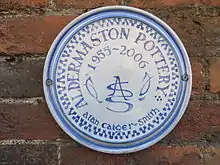Alan Caiger-Smith
Alan Caiger-Smith MBE (1930 – 21 February 2020[1]) was a British studio potter and writer on pottery.

Life and work
Caiger-Smith was born in Buenos Aires, Argentina. He studied at the Camberwell School of Arts and Crafts and read history at King's College, Cambridge (1949-1952). He trained in pottery at the Central School of Art & Design in 1954 under Dora Billington.[2]
According to Grove Art, Alan Caiger-Smith established the Aldermaston Pottery in 1955, "a cooperative workshop of about seven potters making functional domestic ware and tiles, as well as individual commissions and one-off pots. By trial and error he revived and perfected two virtually lost techniques: the use of tin glaze and painted pigments on red earthenware clay, and the firing of lustres on to tin glazes."[3] However, "virtually lost" is questionable: in his Lustre Pottery, Caiger-Smith himself covers relatively recent revivals of lustreware by William De Morgan, Vilmos Zsolnay, Clément Massier and Pilkington's Royal Lancastrian Pottery.[4] In particular his researches "reconstructed the medieval Islamic lustreware technique".[5]
He was joined at Aldermaston Pottery by a number of other potters, including Geoffrey Eastop (1921–2014).[6]
Alan Caiger-Smith's book on Tin-Glaze Pottery (1973) covers its history and much of its technique.[7] He co-translated and annotated with R.W. Lightbown a detailed contemporary description of the materials and methods of Renaissance maiolica, Cipriano Piccolpasso's I Tre Libre Dell'Arte Del Vasaio (The Three Books of the Potter’s Art) (1980). His history of lustre ware, Lustre Pottery, was published in 1985.
Caiger-Smith was Chairman of the British Crafts Centre (1973–1978) and was awarded the MBE in 1988.[2] He ceased employing assistants in 1993 to concentrate on personal work and in 2006 announced his decision to sell the Aldermaston Pottery.[8]
Bibliography
- Caiger-Smith, Alan, Tin-Glaze Pottery in Europe and the Islamic World: The Tradition of 1000 Years in Maiolica, Faience and Delftware (Faber and Faber, 1973). ISBN 0-571-09349-3.
- Caiger-Smith, Alan, Lustre Pottery: Technique, Tradition and Innovation in Islam and the Western World(Faber and Faber, 1985). ISBN 0-571-13507-2.
- Caiger-Smith, Alan, Pottery, People and Time: A Workshop in Action (Shepton Beauchamp: Richard Dennis, 1995). ISBN 0-903685-39-6.
- Piccolpasso, Cipriano, The Three Books of the Potter's Art (I Tre Libri del Arte Vasaiao) (trans. A. Caiger-Smith and R. Lightbown) (Scolar Press, 1980). ISBN 0-85967-452-5.
- Caiger-Smith, Alan, Said el Sadr 1909-1986. Potter, Painter, Sculptor, Teacher. (ACS Shalford Publications, 2010). ISBN 0956416608
- Caiger-Smith, Alan, Times and Seasons (I Tempi e le Stagioni) (Published 2012 in English and Italian). ISBN 9788897738244
- White Jane, Alan Caiger-Smith and the Legacy of Aldermaston Pottery', Ashmolean Museum, Oxford, 2018 EAN 9781910807255
See also
- Tin-glazed pottery
- Primavera Gallery in Cambridge
- Reading Museum has a large collection of Caiger-Smith's pottery[9]
References
- "Alan CAIGER-SMITH". Newbury Today. Retrieved 29 February 2020.
- Watson, Oliver (1993). Studio Pottery. London: Phaidon Press. ISBN 9780714829487.
- Niblett, Kathy. "Caiger-Smith, Alan". Grove Art Online. Oxford Art Online.
- Caiger-Smith, Alan (1989). Lustre Pottery. London: Faber & Faber.
- Freestone, Ian, Gaimster, David R. M. (eds), Pottery in the Making: World Ceramic Traditions, 1997, British Museum Publications, ISBN 071411782X: Sheila Canby, p. 111 (quoted), Emmanuel Cooper, p. 208
- "Geoffrey Eastop: An artist's life in pots". Newbury Weekly News. Newbury, Berkshire. 15 January 2015. pp. 44–45.
- Caiger-Smith, Alan (1973). Tin-Glaze Pottery in Europe and the Islamic World: The Tradition of 1000 Years in Maiolica, Faience and Delftware. Faber and Faber. ISBN 0571093493.
- "[title missing]". Ceramic Review (221 (September/October)): 17. 2006.
- https://www.readingmuseum.org.uk/your-visit/permanent-galleries/atrium